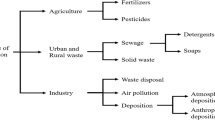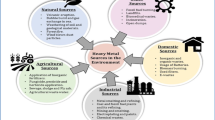Abstract
The application of electrical fields and chelating agents is an innovative hybrid technology used for the decontamination of soil polluted by heavy metals. The effects of four center-oriented electrical fields and chelating agents on active fractions of lead and zinc were investigated in this pot experiment. Ethylenediaminetetraacetic acid (EDTA) as a synthetic chelator and cow manure extract (CME) and poultry manure extract (PME) as natural chelators were applied to the pots (2 g kg−1) 30 days after the first irrigation. Two weeks later, four center-oriented electrical fields were applied in each pot (in three levels of 0, 10, and 30 V) for 1 h each day for 14 days. The soil near the cathode and anodes was collected and analyzed as cathodic and anodic soil, respectively. Results indicated that the soluble–exchangeable fraction of lead and zinc were decreased in the cathodic soil, while the carbonate-bound fractions were increased. In the anodic soil, however, the opposite result was observed. EDTA enhanced the soluble–exchangeable form of the metals in both anodic and cathodic soils. Furthermore, the amounts of carbonate-bound heavy metals were increased by the application of CME in both soils. The organic-bound fraction of the metals was increased by the application of natural chelators, while electrical fields had no significant impacts on this fraction.







Similar content being viewed by others
References
Acar, Y. B., & Alshawabkeh, A. N. (1993). Principles of electrokinetic remediation. Environmental Science and Technology, 27, 2638–2647.
Alcántara, M. T., Gómez, J., Pazos, M., & Sanromán, M. A. (2010). Electrokinetic remediation of PAH mixtures from kaolin. Journal of Hazardous Materials, 179, 1156–1160.
Altin, A., & Degirmenci, M. (2005). Lead (II) removal from natural soils by enhanced electrokinetic remediation. Science of the Total Environment, 337, 1–10.
Baek, K., Kim, D. H., Park, S. W., Ryu, B. G., Batjargal, T., & Yang, J. S. (2009). Electrolyte conditioning-enhanced electrokinetic remediation of arsenic-contaminated mine tailing. Journal of Hazardous Materials, 161, 457–462.
Bower, C. A., Reitemeier, R. F., & Fireman, M. (1952). Exchangeable cation analysis of saline and alkali soils. Soil Science, 73, 251–261.
Bruell, C. J., Segall, B. A., & Walsh, M. T. (1992). Electroosmotic removal of gasoline hydrocarbons and TCE from clay. Journal Environmental Engineering, 118, 68–83.
Cang, L., Wang, Q. Y., Zhou, D. M., & Xu, H. (2011). Effects of electrokinetic-assisted phytoremediation of a multiple-metal contaminated soil on soil metal bioavailability and uptake by Indian mustard. Separation Purification Technology, 79, 246–253.
Debra, L., Van, E., Rachel, C., Sharpe-Pedler, & Kevin, K. M. (2007). Effect of chelating agents and solubility of cadmium complexes on uptake from soil by Brassica juncea. Chemosphere, 68, 401–408.
Elzinga, E. J., & Reeder, R. J. (2002). X-ray absorption spectroscopy study of Cu+2 and Zn2+ adsorption complexes at the calcite surface: implications for site specific metal incorporation preferences during calcite crystal growth. Geochimica et Cosmochimica Acta, 66, 3943–3954.
FDA (Food and Drug Administration) (2001). Dietary reference intakes for vitamin A, vitamin K, Arsenic, boron, chromium, copper, iodine, iron, manganese, molybdenum, nickel, silicon, vanadium, and zinc. Report of the Panel on Micronutrients. National Academy Press, Washington, DC, Food and Drug Administration. Dietary Supplements. Center for Food Safety and Applied Nutrition
Garbarino, J. R., Hayes, H., Roth, D., Antweider, R., Brinton, T. I., & Taylor, H. (1995). Contaminants in the Mississippi river. Virginia: U.S. Geological Survey Circular. 1133.
Giannis, A., Pentari, D., Wang, J. Y., & Gidarakos, E. (2010). Application of sequential extraction analysis to electrokinetic remediation of cadmium, nickel and zinc from contaminated soils. Journal of Hazardous Materials, 184, 547–554.
Huang, J. W. W., Chen, J. J., Berti, W. R., & Cunningham, S. D. (1997). Phytoremediation of lead-contaminated soils, role of synthetic chelates in lead phytoextraction. Environmental Science and Technology, 3, 800–805.
Kim, D. H., Jeon, C. S., Baek, K., Ko, S. W., & Yang, J. S. (2009). Electrokinetic remediation of fluorine-contaminated soil, conditioning of anolyte. Journal of Hazardous Materials, 161, 565–569.
Kim, S. O., & Kim, K. W. (2001). Monitoring of electrokinetic removal of heavy metals in tailing-soils using sequential extraction analysis. Journal of Hazardous Materials, 85, 195–211.
Klute, A. (1986) Methods of Soil Analysis: Part 1-Physical and Mineralogical Methods (second ed.). Madison, USA: Soil Science Society of America.
Kos, B., & Lestan, D. (2004). Chelator induced phytoextraction and in situ soil washing of Cu. Environmental Pollution, 132, 333–339.
Lestan, D., Luo, C. L., & Li, X. D. (2008). The use of chelating agents in the remediation of metal-contaminated soils, a review. Environmental Pollution, 153, 3–13.
Lim, J. M., Salido, A. L., & Butcher, D. J. (2004). Phytoremediation of lead using Indian mustard (Brassica juncea) with EDTA and electrodic. Microchemical Journal, 76, 3–9.
Mulligan, C. N., Yong, R. N., & Gibbs, B. F. (2001). Surfactantenhanced remediation of contaminated soil, a review. Engineering Geology, 60, 371–380.
Page, A.L., Miller, R.H., Keeney, D.R. (1992) Methods of soil analysis. Part 2. Chemical and microbiological methods, 2nd ed. Soil Science Society of America. Monograph 9, WI, USA.
Pazos, M., Cameselle, C., & Sanroman, M. A. (2008). Remediation of dye-polluted kaolinite by combination of electrokinetic remediation and electrochemical treatment. Environ Engin Sci, 25, 419–428.
Polcaro, A. M., Vacca, A., Mascia, M., & Palmas, S. (2007). Electrokinetic removal of 2,6-dichlorophenol and diuron from kaolinite and humic acid-clay system. Journal of Hazardous Materials, 148, 505–512.
Reddy, K., & Chinthamreddy, S. (1999). Electrokinetic remediation of heavy metal-contaminated soils under reducing environments. Waste Management, 19, 269–282.
Reddy, K., Donahue, M., & Sasaoka, R. (1999). Preliminary assessment of electrokinetic remediation of soil and sludge contaminated with mixed waste. Air Waste Management Association, 49, 823–830.
Reddy, K., & Parupudi, U. S. (1997). Effects of soil composition on the removal of chromium by electrokinetics. Journal of Hazardous Materials, 55, 135–158.
Reddy, K. R., Xu, C. Y., & Chinthamreddy, S. (2001). Assessment of electrokinetic removal of heavy metals from soils by sequential extraction analysis. Journal of Hazardous Materials, B84, 279–296.
Ritchie, J. M., Cresser, M., & Cotter-Howells, J. (2001). Toxicological response of a bioluminescent microbial assay to Zn, Pb and Cu in an artificial soil solution, relationship with total metal concentrations and free ion activities. Environmental Pollution, 114, 129–136.
Safari Sinegani, A. A., & Khalilikhah, F. (2011). The effect of application time of mobilising agents on growth and phytoextraction of lead by Brassica napus from a calcareous mine soil. Environmental Chemistry Letters, 9, 259–265.
Safari Singani, A. A., & Ahmadi, P. (2012). Manure application and cannabis cultivation influence on speciation of lead and cadmium by selective sequential extraction. Soil Sedimentary Contamination, 21(3), 305–321.
Sah, J. G., & Che, N. J. Y. (1998). Study of the electrokinetic process on Cd and Pb-spiked soils. Journal of Hazardous Materials, 58, 301–315.
Salt, D. E., Blaylock, M., Kumar, N. P. B. A., Dushenkov, V., Ensley, B. D., Chet, I., et al. (1995). Phytoremediation—a novel strategy for the removal of toxic metals from the environment using plants. Biotech, 13, 468–474.
Serrano, S., Carrido, F., Campbell, C. G., & Garcia-Gonzalez, M. T. (2005). Competitive sorption of cadmium and lead in acid soils of central Spain. Geoderma, 124, 91–104.
Shen, Z., Chen, X., Jia, J., Qu, L., & Wang, W. (2007). Comparison of electrokinetic soil remediation methods using one fixed anode and approaching anodes. Environmental Pollution, 150, 193–199.
Sims, R. C. (1990). Soil remediation techniques at uncontrolled hazardous waste sites (pp. 704–732). Utah: Utah State University.
Sogorka, D. B., Gabert, H., & Sogorka, B. J. (1998). Emerging technologies for soils contaminated with metals electrokinetic remediation. Hazard Industry Wastes, 30, 673–685.
Sposito, G., Lund, J., & Change, A. C. (1982). Trace metal chemistry in arid zone field soils amended with sewage sludge: I. Fractionation of Ni, Cu, and Pb in solid phases. Soil Science Society of America Journal, 46, 260–264.
Suer, P., Gitye, K., & Allard, B. (2003). Speciation and transport of heavy metals and macro elements during electro remediation. Environmental Science and Technology, 37, 177–181.
United States Environmental Protection Agency (USEPA). (2000). Introduction to phytoremediation (EPA 600/R-99/107). Cincinnati, OH, USA: USEPA Office of Research and Development.
United States Environmental Protection Agency (USEPA) (1998). Revised guidance document for the remediation of contaminated soils. US Environmental Protection Agency Annual Review.
Viadero, R. C., Reed, B. E., Berg, M., & Ramsay, J. (1998). A laboratory scale study of applied voltage on the electrokinetic separation of lead from soils. Separation Science and Technology, 33(12), 1833–1859.
Virkutyteat, J., Sillanpa, M., & Latostenmaab, P. (2002). Electrokinetic soil remediation critical overview. Science of the Total Environment, 289, 97–121.
Wang, J. Y., Huang, X. J., Kao, J. C. M., & Stabnikova, O. (2006). Removal of heavy metals from kaolin using an upward electrokinetic soil remedial (UESR) technology. Journal of Hazardous Materials, 136, 532–541.
Zhou, D. M., Deng, C. F., Cang, L., & Alshawabkeh, A. N. (2005). Electrokinetic remediation of a Cu–Zn contaminated red soil by controlling the voltage and conditioning catholyte pH. Chemosphere, 61, 519–552.
Author information
Authors and Affiliations
Corresponding author
Rights and permissions
About this article
Cite this article
Tahmasbian, I., Safari Sinegani, A.A. Monitoring the effects of chelating agents and electrical fields on active forms of Pb and Zn in contaminated soil. Environ Monit Assess 185, 8847–8860 (2013). https://doi.org/10.1007/s10661-013-3217-0
Received:
Accepted:
Published:
Issue Date:
DOI: https://doi.org/10.1007/s10661-013-3217-0




